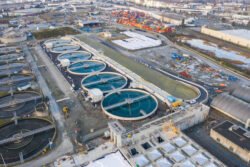
Central Contra Costa Sanitary District Wastewater Treatment Plant

Central Contra Costa Sanitary District Wastewater Treatment Plant: A Comprehensive Overview
Introduction
The Central Contra Costa Sanitary District (Central San) Wastewater Treatment Plant (WWTP) stands as an integral part of the community’s infrastructure in Contra Costa County, California. Serving a substantial population, handling vast volumes of wastewater, and progressing with several key projects, the plant plays a pivotal role in safeguarding public health and the environment. This article delves into the diverse aspects of the Central San WWTP, detailing its operational capacities, recent developments, and engagement with the community.
Population Served
Central San serves a population of approximately 484,300 people across a 145-square-mile service area, which includes central Contra Costa County and the neighboring communities. This area encompasses cities including, but not limited to, Concord, Walnut Creek, Pleasant Hill, and Danville. The district constitutes a blend of residential, commercial, and industrial zones, each contributing to the wastewater flow that the plant must process and treat efficiently.
Wastewater Volume and Treatment Capacity
The Central San WWTP is designed to handle substantial volumes of wastewater daily. On average, the plant processes about 32 million gallons of wastewater each day. However, during storm events, these volumes can double or triple, pushing the facility to operate at its peak capacity of 53.8 million gallons per day (MGD). The plant is equipped to handle these fluctuations, ensuring uninterrupted service despite their challenging nature.
Treatment Process
The treatment process at Central San WWTP is intricate and multi-staged, ensuring that the effluent discharged meets stringent environmental standards. The treatment process comprises primary, secondary, and tertiary phases.
-
- Primary Treatment: This initial stage involves the removal of large solids and grit from wastewater. Mechanical screens and sedimentation tanks facilitate the settling and removal of these materials.
-
- Secondary Treatment: Utilizing activated sludge processes, this phase targets the breakdown of organic materials through aerobic microbial processes. This stage significantly reduces Biological Oxygen Demand (BOD) and Suspended Solids (SS).
-
- Tertiary Treatment: The final phase involves advanced filtration and disinfection, primarily through chlorination or ultraviolet light, ensuring that the effluent is safe for discharge into Suisun Bay.
Additionally, Central San is renowned for its effective biosolids management program. The bi-products from the treatment process are treated further to be safely reused as soil amendments or for other beneficial purposes.
Recent Local News
Recent developments and news surrounding Central San WWTP highlight the district’s ongoing commitment to improving service and environmental stewardship.
-
- Operational Enhancements: The district is in the final stages of commissioning a new headworks facility, which promises enhanced grit and debris removal, safeguarding downstream processes and equipment. This project represents a significant investment in maintaining the plant’s operational reliability.
-
- Innovative Energy Projects: Central San has garnered attention for its strides in energy efficiency. The district has implemented cogeneration systems that utilize biogas generated from the anaerobic digestion process to produce electricity and heat. This project aligns with the broader goal of sustainability and reducing the facility’s carbon footprint.
-
- Permit Approvals: In 2022, Central San achieved a milestone with the renewal of its National Pollutant Discharge Elimination System (NPDES) permit. This permit, granted by the California Regional Water Quality Control Board, signifies compliance with all environmental regulations, ensuring the ongoing protection of local waterways.
Key Projects
Central San WWTP continually pursues projects aimed at enhancing capacity, resilience, and environmental performance. Some of the key projects include:
-
- Resource Recovery Program: This initiative focuses on the recovery of valuable resources from wastewater. Projects under this program encompass biosolids management, nutrient recovery, and recycled water expansion. Notably, Central San is a part of the regional recycled water program, producing high-quality recycled water for landscape irrigation, industrial use, and agriculture.
-
- Plant Upgradation and Expansion: The existing infrastructure is undergoing a series of upgrades. Key components such as the aeration system, final clarifiers, and disinfection facilities are being modernized to bolster the plant’s capacity and efficiency. The upgrades are designed to accommodate future growth in the population served and comply with even stricter regulatory standards.
-
- Advanced Water Purification: Central San is exploring advanced water purification technologies that could potentially allow for direct potable reuse in the future. This aligns with California’s broader vision of improving water sustainability and resilience against prolonged droughts and climate change.
Community Engagement
Community engagement remains a cornerstone of Central San’s operational philosophy. The district recognizes that proactive communication and involvement with the community yield mutual benefits.
-
- Educational Outreach: Central San conducts regular tours of the WWTP for schools, community groups, and industry professionals. These tours are part of a broader educational outreach campaign aimed at raising awareness about the critical role of wastewater treatment and the importance of water conservation.
-
- Public Participation: The district holds public meetings and hearings to solicit community input on key projects and policy changes. These forums provide transparency and allow residents to voice their concerns and suggestions.
-
- Community Programs: Central San invests in community programs, including the popular Household Hazardous Waste Collection Facility. This facility enables residents to dispose of hazardous waste safely, protecting both the community and the environment.
-
- Youth Programs: Initiatives such as the “Central San Academy” engage younger demographics, providing internship opportunities, scholarships, and educational materials that foster an understanding of environmental sciences and engineering careers.
Conclusion
The Central Contra Costa Sanitary District Wastewater Treatment Plant stands as a beacon of efficient and sustainable wastewater management. By serving a large and diverse population, handling significant volumes of wastewater, and pursuing innovative projects, Central San ensures the protection of public health and the environment. Its commitment to continuous improvement, community engagement, and regulatory compliance establishes the district as a leader in the field of wastewater treatment. As the region grows and evolves, Central San WWTP will undoubtedly continue to adapt, innovate, and provide exemplary service to the communities it serves.
